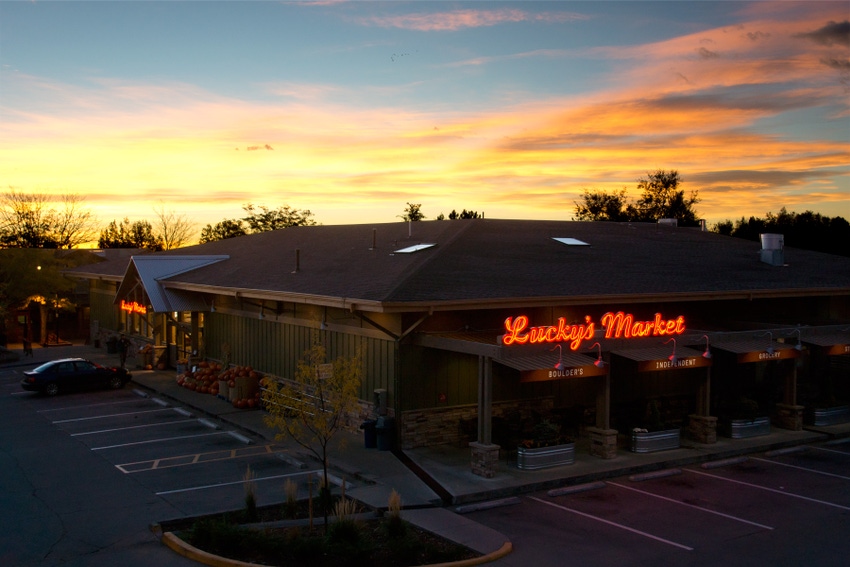
Lucky’s Market gives local products a shot. Period. New vendors need not face loads of paperwork or multiple meetings. Rather, for store owner Bo Sharon, relationships start with a cup of coffee and end with a handshake. For Sharon, it’s about celebrating and supporting his community, which has done the same for him.
Sharon’s no-nonsense approach has made Boulder, Colo.-based Lucky’s a go-to store for many brands looking to break into grocery retail, but local companies always get priority. Last fall, he opened a bakery and creamery adjacent to the market, and this summer he’ll open a second, 26,000-square-foot store in Longmont, Colo. He’s also planning a 5-acre organic farm to produce even more local products for his stores and to better connect shoppers with their food. The farm complements the retailer’s support of Transition Colorado, a program that urges consumers to make 10 percent of their food choices local. Here, Sharon talks about why he went local before it was cool.
Natural Foods Merchandiser: What does local mean in your store?
Bo Sharon: We define local a couple of ways. We use the word homegrown to identify foods produced within Boulder County. Local means anything from Colorado. Although others push the government’s local definition of anything produced within 450 miles, arguably, Nebraska is not Colorado. Signs throughout our store display the distance particular items have traveled. For every local finished product, we also list where the company is based. In addition to tracking, this helps people connect to the place an item is grown, sourced, bottled, packaged or brewed. Knowing where your food comes from helps bond the connection between shopping and what you’re putting in your body.
NFM: Why have you made such a commitment to local foods?
BS: We were local before it was cool—and local by default. We’re local folks; we do business with local people. I’ve been criticized for not signing contracts and actually relying on my handshake. But that’s the way business used to be done, and for us, it’s the only way to do business. I can speak of various folks who have launched natural food companies in Boulder, and we always started with a handshake, a relationship, a cup of coffee and a talk. To me, it’s just a more intimate way of connecting with food.
NFM: How does your bakery and creamery align with your mission?
BS: We use natural, organic and local ingredients when possible. If we’re making zucchini bread, we use nearby Isabelle Farm’s zucchini, while our peanut-butter ice cream uses Boulder-based Justin’s peanut butter. Natural is a baked term these days, but for us it means natural food colors and organic when possible. Our ice cream is made from organic cane sugar and organic cream from small farms. You can’t go just anywhere and get this stuff, so why not do it ourselves? The idea is to delight people and provide another place for them to connect.
NFM: How did you get involved with Transition Colorado?
BS: Michael Brownlee approached me with this idea of trying to grow the Colorado food shed by raising awareness for local foods. He and his wife started Transition Colorado, which encourages people to pledge to purchase 10 percent of their food from local producers and offers an online tool to help folks chart what they buy. Our mission as a store has always been to raise awareness and spread the word about local food, so the program slid perfectly into what we do every day. I think Lucky’s was its first sponsor. For us, it’s about getting people to take a moment to reflect and account for how they grocery shop. Reading about a product’s origins takes more time and can feel like a chore; this was a unique way of presenting it to folks.
3 tips to get more local products into your store
Go local, big time. While Sharon encourages shoppers to make 10 percent of their purchases from local producers, his store exceeded that commitment long ago. During the growing season, roughly 60 percent of Lucky’s produce comes from local growers. In the winter, Sharon balances imported produce offerings with new local products in center aisles.
Foster vendor growth. Getting local brands on the shelves is only part of Lucky’s mission. Just as important is helping young companies grow. In addition to looking at hard sales data, Sharon and his team use instincts honed from years of experience to help entrepreneurs determine how their products can best succeed in the marketplace. “It’s a very open conversation, and we’re a very open company,” Sharon says. “If you want to talk to the grocery buyer, he’s right here. If you want to talk to me, I’m right here. There’s not a whole lot of hoopla.”
Hit the pavement. Today, Lucky’s is often the first stop for local vendors bringing new products to market, but it wasn’t always this way. To build a reputation as a store that appreciates craftsmanship, Sharon and his team visited farmers’ markets and spoke with shoppers and local chefs to zero in on the best local products to stock. “Farmers and artisans often don’t think of a grocery store as a typical venue for their products,” Sharon says. “A little encouragement can open up your store to high-quality foods that the competition has yet to discover.”
About the Author(s)
You May Also Like
.png?width=700&auto=webp&quality=80&disable=upscale)




